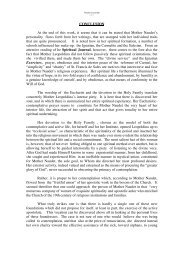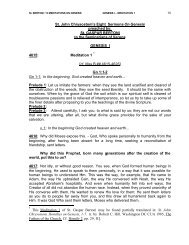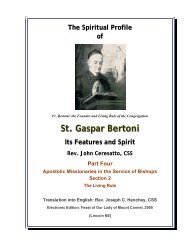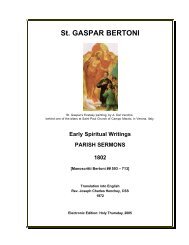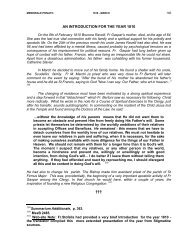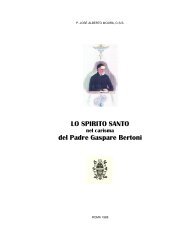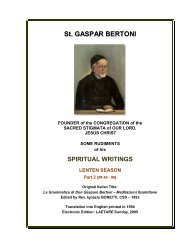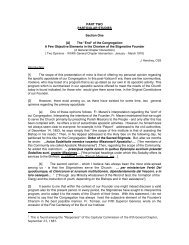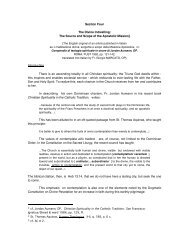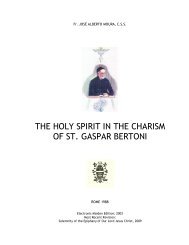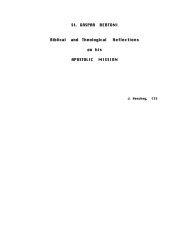[B.] St. IGNATIUS of LOYOLA Presentation: The ... - St. Gaspar Bertoni
[B.] St. IGNATIUS of LOYOLA Presentation: The ... - St. Gaspar Bertoni
[B.] St. IGNATIUS of LOYOLA Presentation: The ... - St. Gaspar Bertoni
You also want an ePaper? Increase the reach of your titles
YUMPU automatically turns print PDFs into web optimized ePapers that Google loves.
INTEGRE;SJ-OFM<br />
= 12 =<br />
k. <strong>The</strong> definitive vocation <strong>of</strong> the Christian is not death, but the Joy <strong>of</strong> the<br />
Resurrection <strong>of</strong> the Lord, the recognition <strong>of</strong> the divinity through the glorious body <strong>of</strong> Jesus,<br />
in the manifestation <strong>of</strong> His Wounds [cf. Jn 20]. Jesus, as God’s only begotten, most beloved<br />
Son, establishes the New Creation. This is a new relationship <strong>of</strong> that same love that unites Jesus<br />
with His Father, through the Holy Spirit. This agape’ is communicated, shared with the<br />
baptized, the consecrated into Christ Jesus - in the form <strong>of</strong> love and fidelity in the Risen Christ.<br />
All <strong>of</strong> the believers are being called to become more and more children <strong>of</strong> the most High, sharing<br />
in Jesus’ own Filiation, by participation in the glorious life <strong>of</strong> the Risen Lord. This is kept alive<br />
through the Contemplation toward Love.<br />
4. <strong>The</strong> <strong>St</strong>ructure <strong>of</strong> Ignatius’ Text:<br />
a. <strong>The</strong> very brief document <strong>of</strong> the Fourth Week <strong>of</strong> the Spiritual Exercises, as<br />
these result from the pen <strong>of</strong> <strong>St</strong>. Ignatius, is composed <strong>of</strong> three basic elements, and their subdivisions:<br />
- the appearance <strong>of</strong> the Risen Lord to Our Lady [cf. SE, ## 218-220];<br />
- three considerations that guide the contemplation:<br />
- the petition for the grace <strong>of</strong> the Fourth Week [cf.SE #221];<br />
- the divine showing <strong>of</strong> His Divinity [SE # 224];<br />
- the <strong>of</strong>fice <strong>of</strong> “Consoler” Who permeates the Risen One [SE # 224].<br />
- the four “Notes” which really, <strong>of</strong> their nature, pertain to the interior and practical running<br />
<strong>of</strong> the Spiritual Exercises - but, these <strong>of</strong>fer fruit from any careful reflecting upon them.<br />
b. From this “structure” the student may note those basic points, that fundamental<br />
orbit, within which the contemplation <strong>of</strong> the retreatant should gravitate. This appearance to Our<br />
Lady fulfills a paradigmatic function. <strong>The</strong>n, the complementarity <strong>of</strong> the three considerations [cf.<br />
SE ## 221; 223;224] guide and center the attention <strong>of</strong> the very ultimate meaning <strong>of</strong> the<br />
Resurrection in the life <strong>of</strong> the Church. <strong>The</strong>se few elements are those which <strong>of</strong>fer the key <strong>of</strong><br />
Ignatius; own understanding <strong>of</strong> this Encounter with the Crucified, Who is now Risen. <strong>The</strong><br />
Contemplation toward Love leads to a hope-filled APOSTOLIC MISSION.<br />
299].<br />
1.] <strong>The</strong> Appearance <strong>of</strong> the Risen Lord to Our Lady [cf. SE ## 218-225;<br />
a.] For this non-biblical scene with all probability <strong>St</strong>. Ignatius had as<br />
his source <strong>The</strong> Life <strong>of</strong> Christ, by Ludolf <strong>of</strong> Saxony, ‘the Carthusian’, who speaks <strong>of</strong> just such an<br />
apparition. For both writers, Jesus’ appearance after His Resurrection to His Mother is the very<br />
first such encounter for Him, and both treat <strong>of</strong> it in the same way, in ’explaining away’ the silence<br />
<strong>of</strong> the Scriptures in this regard.<br />
[1] “<strong>The</strong> Carthusian” explains the appearance and the<br />
reason for Scripture’s silence as follows: He appeared to her at the very outset <strong>of</strong> His glory.<br />
Jesus Christ came to her, her most beloved Son, dressed in the brilliant white <strong>of</strong> His glorious<br />
refulgence. This vesture represented the habit <strong>of</strong> the lasting glory and the dignity <strong>of</strong> His new<br />
Resurrection. And then that King <strong>of</strong> kings conducted the report on how He had gone down to the<br />
nether-world and how He had emptied that infernal prison <strong>of</strong> those faithful ones who had awaited<br />
Him.<br />
[2] With just such an admirable appearance, the Prince <strong>of</strong><br />
Glory, it is piously believed, came to the glorious Virgin. Nothing about this is recorded in the holy<br />
Gospel, but it is believed that He conducted this as the first <strong>of</strong> His appearances. It is simply basic<br />
piety that it should have been thus. This seems implied in the readings <strong>of</strong> the subsequent<br />
appearances <strong>of</strong> the Risen One.


![[B.] St. IGNATIUS of LOYOLA Presentation: The ... - St. Gaspar Bertoni](https://img.yumpu.com/33393889/12/500x640/b-st-ignatius-of-loyola-presentation-the-st-gaspar-bertoni.jpg)
